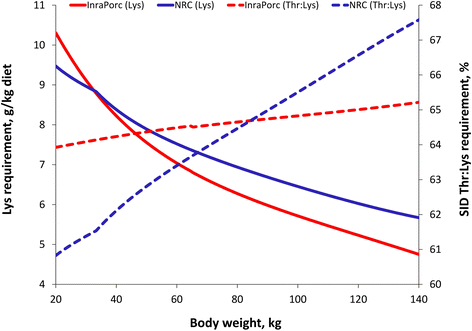Concept and application of ideal protein for pigs
- PMID: 25937926
- PMCID: PMC4416387
- DOI: 10.1186/s40104-015-0016-1
Concept and application of ideal protein for pigs
Abstract
Knowledge about the amino acid requirements and the response of pigs to the amino acid supply is essential in feed formulation. A deficient AA supply results in a reduction in performance while an oversupply is costly and leads to excessive nitrogen excretion with a potentially negative environmental impact. Amino acid requirements are determined to a large extent by the protein deposition in the body and, for lactating sows, by the protein exported in the milk. The concept of ideal protein was developed more than 50 years ago and refers to a protein with an amino acid profile that exactly meets the animal's requirement so that all amino acids are equally limiting for performance. Because Lys typically is the first-limiting amino acid, the ideal amino acid profile is often expressed relative to Lys. Although the ideal protein profile is often assumed to be constant for a given production stage, (small) changes in the ideal protein profile can occur within a production stage. This can be caused by changes in the relative contribution of the different components of amino acid requirements during the productive life on the animal (e.g. changes in the relative contribution of growth and maintenance). Amino acids requirements can be determined experimentally using dose-response studies. The design of the study, the chosen response criterion, and the statistical model affect the requirement estimate. Although considerable experimental work has been carried out to determine the requirements for Lys, Met, Thr, and Trp in growing pigs (and to a lesser extent in sows), little is known about the requirements for the other essential amino acids. Experimental dose-response studies generally focus on the requirement and less on the overall response (i.e. what are the consequences of an amino acid deficiency?). This latter aspect is, to some extent, accounted for in modelling approaches that quantify the response of the animal to the amino acid supply in a dynamic way. The paper describes the origin of ideal protein and illustrates how fundamental concepts of amino acid nutrition have been integrated in practical modeling approaches for the nutrition of growing pigs and sows.
Keywords: Amino acids; Gestation; Growth; Ideal protein; Lactation; Modeling; Pigs.
Figures





References
-
- Mahan DC, Shields RG., Jr Essential and nonessential amino acid composition of pigs from birth to 145 kilograms of body weight, and comparison to other studies. J Anim Sci. 1998;76:513–21. - PubMed
-
- Dourmad JY, Étienne M. Dietary lysine and threonine requirements of the pregnant sow estimated by nitrogen balance. J Anim Sci. 2002;80(8):2144–50. - PubMed
-
- Dourmad JY, Noblet J, Étienne M. Effect of protein and lysine supply on performance, nitrogen balance, and body composition changes of sows during lactation. J Anim Sci. 1998;76(2):542–50. - PubMed
LinkOut - more resources
Full Text Sources
Other Literature Sources
Miscellaneous

